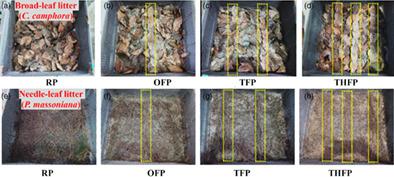当前位置:
X-MOL 学术
›
Hydrol. Process.
›
论文详情
Our official English website, www.x-mol.net, welcomes your
feedback! (Note: you will need to create a separate account there.)
Effect of leaf distribution pattern on the interception storage capacity of leaf litter under simulated rainfall conditions
Hydrological Processes ( IF 2.8 ) Pub Date : 2020-12-23 , DOI: 10.1002/hyp.14022 Kaifeng Li 1 , Longshan Zhao 1, 2, 3 , Rui Hou 1 , Qian Fang 1 , Chunhua Fan 1
Hydrological Processes ( IF 2.8 ) Pub Date : 2020-12-23 , DOI: 10.1002/hyp.14022 Kaifeng Li 1 , Longshan Zhao 1, 2, 3 , Rui Hou 1 , Qian Fang 1 , Chunhua Fan 1
Affiliation

|
Rainwater interception by leaf litter is an important part of forest hydrological processes. The objective of this study was to investigate the interception storage capacity (ISC) of woodland leaf litter for three leaf distribution patterns, one flow path, two flow paths, and three flow paths, manually simulated via one‐by‐one leaf connection in the top leaf litter layer. A random pattern served as the control. Three different slopes (0°, 5° and 25°, representing flat, gentle and steep slopes, respectively) and two contrasting leaf litters (needle‐leaf litter, represented by P. massoniana leaves, and broad‐leaf litter, represented by C. camphora leaves) with a biomass of 0.5 kg/m2 per unit area were applied, at a rainfall intensity of 50 mm/h. Results suggested that leaf distribution pattern greatly impacts litter drainage and hence affects leaf litter ISC. The delaying capacity of litter drainage initiation and ISC of broad‐leaf litter were higher than those of needle‐leaf litter under the same slope conditions. The maximum ISC (Cmax) and minimum ISC (Cmin) of leaf litter at flat and gentle slopes were higher than those at steep slope. Cmin of the broad‐leaf litter was two times higher than that of needle‐leaf litter on average. When raindrops reached the litter layer, some were temporarily intercepted by the top litter layer while others infiltrated leaf litter sublayer along leaf edges, and in the process, some rainwater flowed through litter layer and contributed to lateral litter drainage along the potential flow path formed by leaves. The lateral litter drainage of broad‐leaf litter was higher than that of needle‐leaf litter, and the partitioning of rainwater into lateral litter drainage increased with increases in slope. The difference in leaf litter Cmax among different slopes and leaf shapes decreased with flow path increasing. Therefore, leaf distribution pattern notably impact leaf litter ISC, which is similar to leaf shape and slope impacts. On inclined slopes, avoiding leaf accumulation to form flow path is helpful for improving ISC.
中文翻译:

模拟降雨条件下叶片分布格局对凋落物截留容量的影响
枯枝落叶拦截雨水是森林水文过程的重要组成部分。这项研究的目的是调查林地凋落物对三种叶片分布模式,一条流路,两条流路和三种流路的拦截存储能力(ISC),这些阻力是通过在一对一的叶连接中手动模拟的。顶叶凋落物层。随机模式作为对照。三种不同的斜率(0°,5°和25°,较平坦的,温和和陡坡,分别地)和两种对比叶窝(针叶树垃圾,由下式表示P。马尾松叶和阔叶垃圾,由下式表示Ç。香樟叶)用0.5千克/立方米的生物量2降雨强度为50 mm / h时,每单位面积施肥一次。结果表明,叶的分布方式极大地影响了凋落物的排水,从而影响了凋落物的ISC。在相同的坡度条件下,阔叶垃圾凋落物引发和ISC的延迟能力高于针叶垃圾。平坦和平缓坡面的凋落物的最大ISC(C max)和最小ISC(C min)高于陡坡。C分钟阔叶垃圾的平均水平是针叶垃圾的平均水平的两倍。当雨滴到达凋落物层时,一些雨滴暂时被顶层凋落物层拦截,而另一些则沿着叶缘渗入叶子凋落物亚层,在此过程中,一些雨水流过凋落物层,并沿着由树叶。阔叶垃圾的侧向排水比针叶垃圾的侧向排水更高,雨水在侧向排水中的分配随着坡度的增加而增加。凋落物C max的差异坡度和叶片形状随流径的增加而减小。因此,叶片的分布模式显着影响叶片凋落物的ISC,这与叶片形状和坡度的影响相似。在倾斜的斜坡上,避免叶片堆积形成流路有助于改善ISC。
更新日期:2021-02-15
中文翻译:

模拟降雨条件下叶片分布格局对凋落物截留容量的影响
枯枝落叶拦截雨水是森林水文过程的重要组成部分。这项研究的目的是调查林地凋落物对三种叶片分布模式,一条流路,两条流路和三种流路的拦截存储能力(ISC),这些阻力是通过在一对一的叶连接中手动模拟的。顶叶凋落物层。随机模式作为对照。三种不同的斜率(0°,5°和25°,较平坦的,温和和陡坡,分别地)和两种对比叶窝(针叶树垃圾,由下式表示P。马尾松叶和阔叶垃圾,由下式表示Ç。香樟叶)用0.5千克/立方米的生物量2降雨强度为50 mm / h时,每单位面积施肥一次。结果表明,叶的分布方式极大地影响了凋落物的排水,从而影响了凋落物的ISC。在相同的坡度条件下,阔叶垃圾凋落物引发和ISC的延迟能力高于针叶垃圾。平坦和平缓坡面的凋落物的最大ISC(C max)和最小ISC(C min)高于陡坡。C分钟阔叶垃圾的平均水平是针叶垃圾的平均水平的两倍。当雨滴到达凋落物层时,一些雨滴暂时被顶层凋落物层拦截,而另一些则沿着叶缘渗入叶子凋落物亚层,在此过程中,一些雨水流过凋落物层,并沿着由树叶。阔叶垃圾的侧向排水比针叶垃圾的侧向排水更高,雨水在侧向排水中的分配随着坡度的增加而增加。凋落物C max的差异坡度和叶片形状随流径的增加而减小。因此,叶片的分布模式显着影响叶片凋落物的ISC,这与叶片形状和坡度的影响相似。在倾斜的斜坡上,避免叶片堆积形成流路有助于改善ISC。











































 京公网安备 11010802027423号
京公网安备 11010802027423号